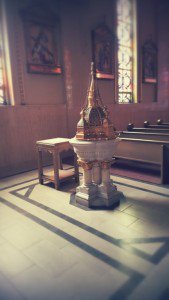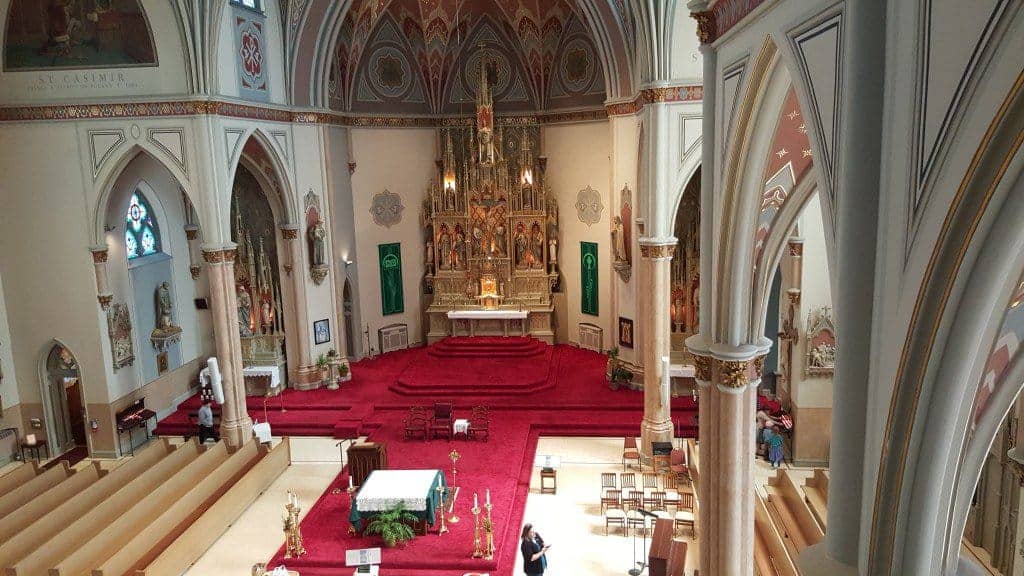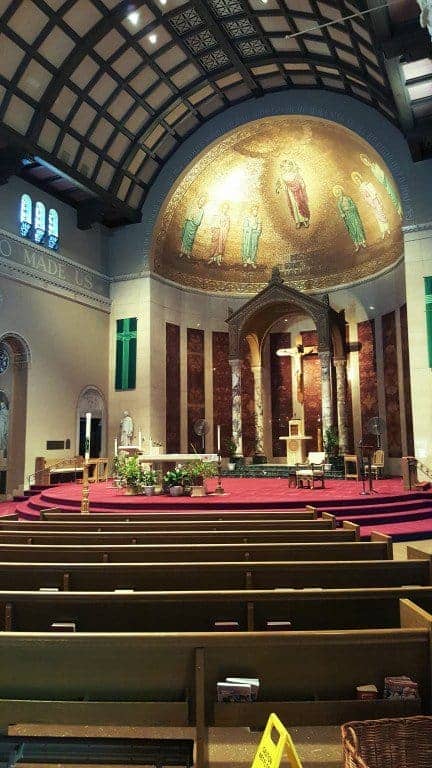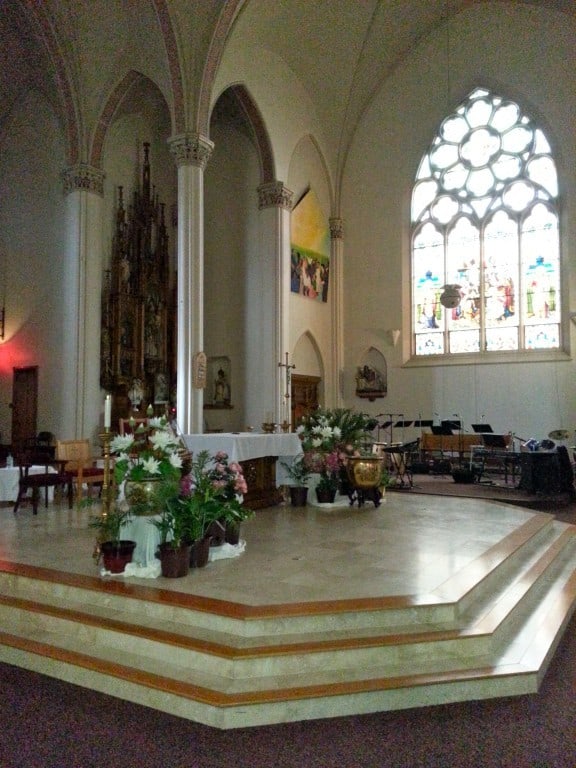Two beautiful stained-glass windows were recently installed in the sanctuary of Saint Stanislaus Oratory on Milwaukee’s South Side. They replaced ugly, dated windows that were put in during the revolutionary era of the 1960s. The elegant new windows depict the Virgin Mary and Saint Stanislaus, obvious choices for this parish. The installation of the traditional windows is a significant step in the overall restoration of the parish, funded entirely by the generosity of its loyal parishioners. For the past several years, the rector of Saint Stanislaus has spearheaded a bold effort to bring this historic Polish church back to its former glory. For reasons that are difficult for any rational person to understand, this beautiful building, the proud work of hundreds of Polish immigrants, fell victim to a catastrophic renovation in the 1960s. I documented this tragedy in detail in previous posts.

The new windows. Courtesy of Dumb Ox Writings. (See more photos at http://latinandabeer.blogspot.com/2015/12/renovation-progress-at-st-stans-in.html)
The purpose of this article is to point out that, by prioritizing the restoration of the church building to its original integrity by erasing vestiges of a dark, confusing era in the Church’s history, Saint Stanislaus is showing the rest of the archdiocese how to bring about a true Springtime and New Evangelization in Milwaukee. The parish is also showing that the liturgy, and not corporate world-inspired marketing plans, is the best place to start any project of renewal. In all of the discussions about how to bring about a “new Pentecost” in Milwaukee, how often do we focus on undoing the systematic iconoclasm that descended upon our churches like a plague, destroying so much of their rich theological symbolism and beauty?
Parishes and diocesan leaders should be looking at what’s going on at Saint Stanislaus for the past couple of years and take notice. We cannot act as though what happened in the 1960s, from the destruction of Communion rails, high altars, and sanctuaries, to the near-universal abandonment of Latin and Gregorian chant, had no effect on the (de)formation of the faithful, in terms of understanding the liturgy and Sacraments. What Archbishop Weakland did to our cathedral (in 2002!) against strong resistance was replicated countless times in churches across Milwaukee and the nation for over forty years.
Let’s be clear: these renovations were not just subjective, minor stylistic/artistic tweaks. They were radical, sweeping assaults on ancient symbols; symbols that had organically developed over the course of centuries for the purpose of forming Catholics in the faith. Undoing the physical damage to the buildings is not a panacea, it’s not a silver bullet, but it should be a priority and would go a long way in helping to restore our identity.
So what has happened at Saint Stanislaus? Here are some highlights that should inspire other parishes.
- The proper and ancient delineation of sacred space has been restored. The sanctuary was brought back to its original layout. There is now a clear demarcation between the sanctuary and nave.
- The low altar, cut out from the original high altar in the ’60s, was reattached to its original place of honor.
- The restored high altar itself was richly embellished to serve as a worthy altar of sacrifice.
- The original marble baptismal font was brought out from hiding and installed in the church.
- A new Communion rail, made of white Carrara marble and green onyx columns, is presently being constructed in Italy and will be installed within a few months. This will replace the original rail that was unfortunately ripped out during the 1960s-era renovations.
- The tacky purple carpet from the ’60s was removed, and hopefully burned and its ashes thrown into Lake Michigan. Elegant new tiling took its place.
- And of course, the new windows will gradually (and mercifully) replace the hideous, broken glass shard windows from the ’60s.
 Recognizing past mistakes requires humility. It also requires a desire to live in reality. What happened at so many parishes in Milwaukee, in terms of radical changes to their interiors, was a huge mistake. We should have the courage to admit that, and then do something about it, rather than turn a blind eye to it. The undoing of those destructive alterations should be a priority in any of the archdiocesan synod discussions. But it’s not a popular topic. And that’s because many people don’t see anything wrong with the renovations and approve of the theological shifts that accompanied them.
Recognizing past mistakes requires humility. It also requires a desire to live in reality. What happened at so many parishes in Milwaukee, in terms of radical changes to their interiors, was a huge mistake. We should have the courage to admit that, and then do something about it, rather than turn a blind eye to it. The undoing of those destructive alterations should be a priority in any of the archdiocesan synod discussions. But it’s not a popular topic. And that’s because many people don’t see anything wrong with the renovations and approve of the theological shifts that accompanied them.
Here is a small sampling of a few historic churches in Milwaukee that are waiting to be restored. Each one perfectly demonstrates what I’m talking about. The sanctuaries have been radically altered and Communion rails ripped out. Read about the history of the Reformation. Thomas Cranmer and Elizabeth I would have applauded these changes. At least they, and the Lutherans, actually had to work hard to ramrod their reforms through. The more recent changes of the ’60s were all self-inflicted.









